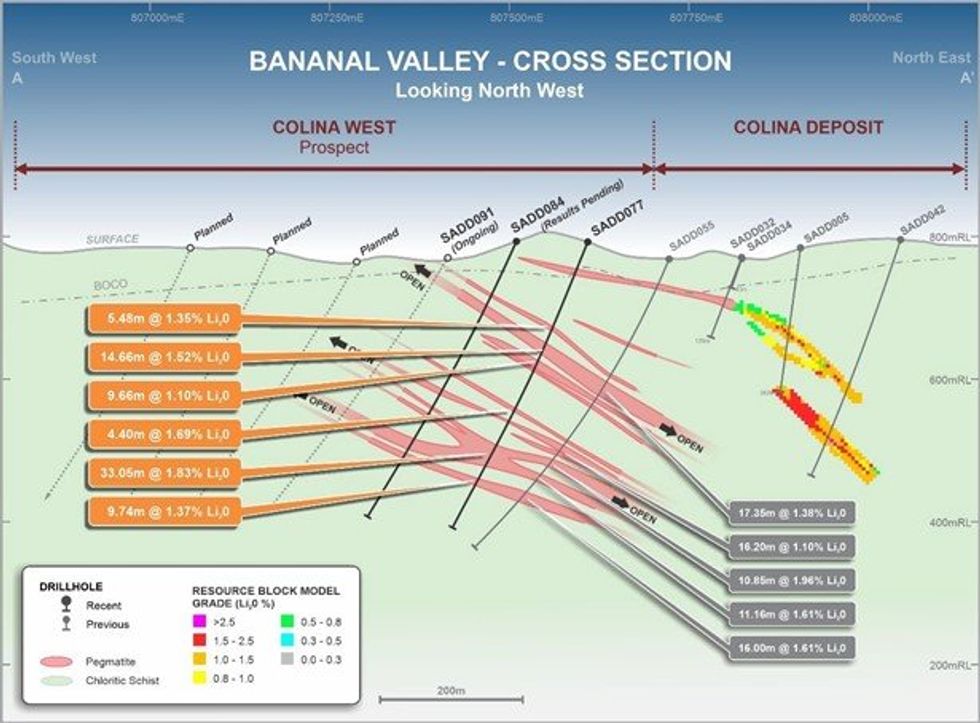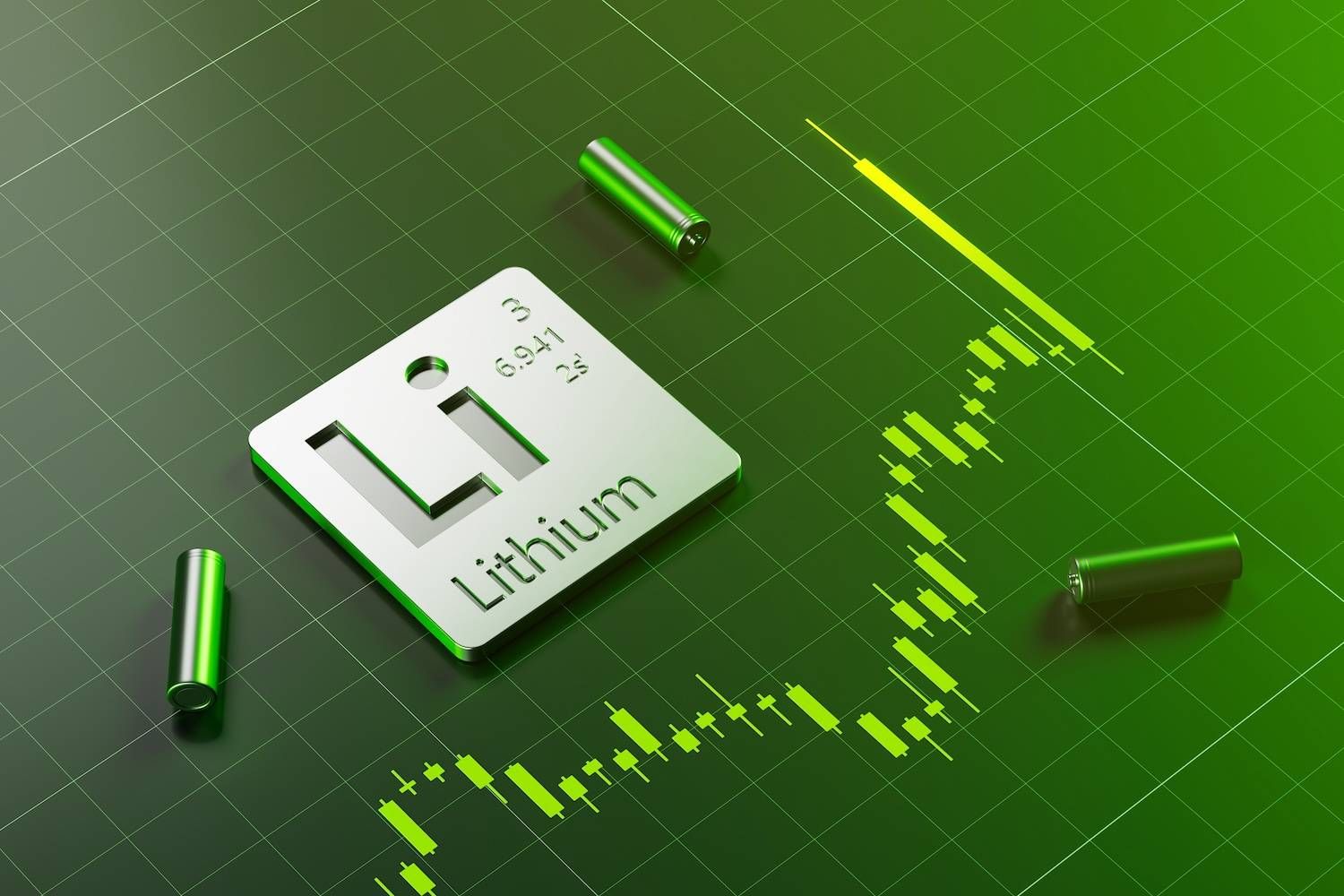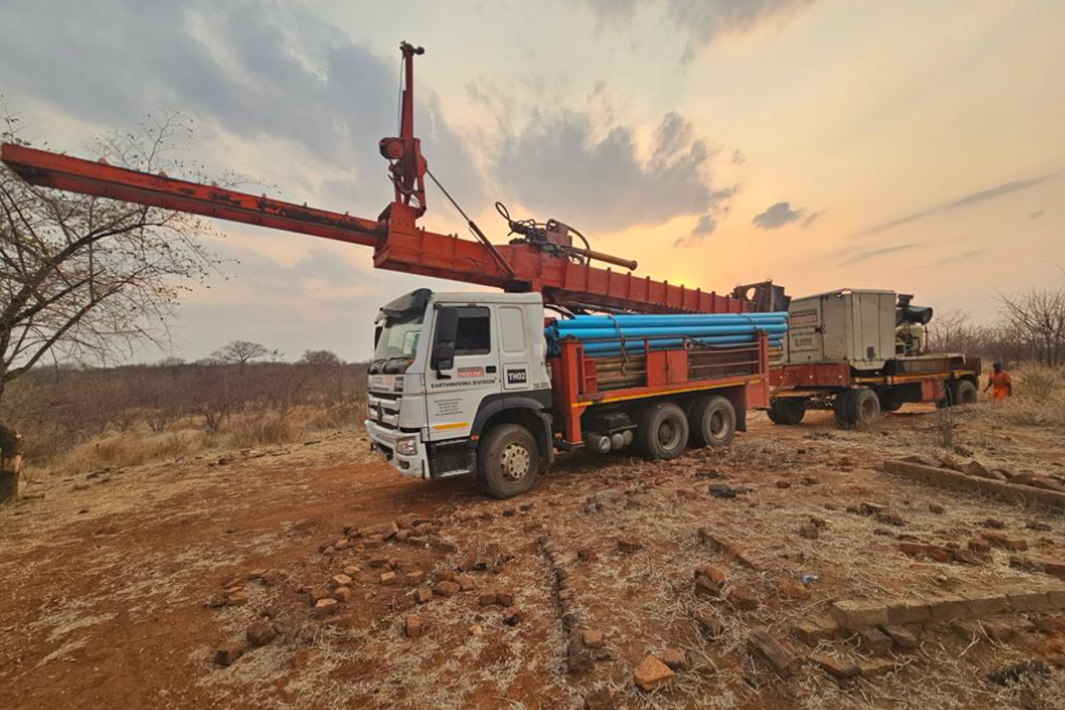
- WORLD EDITIONAustraliaNorth AmericaWorld
March 22, 2023
Latin Resources Limited (ASX: LRS) (“Latin” or “the Company”) is pleased to provide an update on the latest drilling results from resource definition drilling currently underway at the Company’s 100% owned and fully funded Salinas Lithium Project (“Salinas”) in Brazil.
HIGHLIGHTS
- Mineral Resource growth potential confirmed, with latest assay results confirming the presence of multiple thick high-grade pegmatites at Colina West.
- Latest results include:
- SADD072: 26.87m @ 1.62% Li2O from 333.82m
including: 23.00m @ 1.78% Li2O from 335.00m - SADD074: 28.87m @ 1.29% Li2O from 283.13m
- SADD077: 14.66m @ 1.52% Li2O from 158.05m
and: 33.07m @ 1.83% Li2O from 319.53m
- SADD072: 26.87m @ 1.62% Li2O from 333.82m
- Resource definition drilling focused on the Colina and Colina West areas is on track for the planned JORC Mineral Resource Estimate (MRE) upgrade scheduled for June 2023.
- PEA study paused to enable the incorporation of the expanded MRE.
Latin Resources’ Geology Manager, Tony Greenaway Commented:
“Our latest drilling and assay results have confirmed the presence of a major new pegmatite swarm at Colina West. We are seeing pegmatite intersections and grades at Colina West far in excess of those we have seen at Colina itself, which we anticipate will result in a material uplift in the overall mineral resource inventory for the Project. In addition, we are seeing a convergence of Colina and Colina West with the development of a bridging pegmatite swarm between the two areas. We believe that we may in fact be dealing with one large system.
“Our resource definition drilling is well on track, with six diamond rigs moving in a line west from Colina, and one diamond rig drilling the extension of the existing Colina resource model, with more rigs on the way. Our planned JORC resource upgrade, which is scheduled for June, will incorporate the down dip extensions of the existing Colina MRE, as well as bringing in the new pegmatite swarms to the west.
“We have paused the current PEA study which was focused only on our maiden MRE for Colina, so that we can incorporate the June model update, as we believe this will result in a material change in the overall study metrics.”
Resource Definition Drilling
The Company is undertaking a previously announced 65,000 metre diamond drilling campaign, which will incorporate a total of eight diamond drill rigs for the 2023 field season.
The diamond drilling campaign is focusing on resource definition at the Company’s Colina Deposit where a maiden Mineral Resource Estimate (“MRE”)1 was released in early December 2022, as well the systematic drill out of the area to the west of the Colina Deposit, to enable the inclusion of this developing pegmatite system into the planned MRE update.
Colina West Pegmatite Swarm
Recent drilling and assay results from holes completed to the west of Colina, have confirmed what appears to be a second, significantly larger pegmatite swarm, with the development of multiple thick high-grade pegmatites. The Company’s current drilling campaign is progressing from east to west, systematically drilling these pegmatites in an “up-dip” progression (Figure 1 and Figure 2).
Latest drilling intersections from this emerging Colina West swarm include2:
- SADD072: 26.87m @ 1.62% Li2O from 333.82m
- SADD076: 16.53m @ 1.40% Li2O from 334.00m
- SADD077: 14.66m @ 1.52% Li2O from 158.05m
and: 33.05m @ 1.83% Li2O from 319.53m - SADD079: 11.77m @ 1.31% Li2O from 222.68m

Click here for the full ASX Release
This article includes content from Latin Resources, licensed for the purpose of publishing on Investing News Australia. This article does not constitute financial product advice. It is your responsibility to perform proper due diligence before acting upon any information provided here. Please refer to our full disclaimer here.
LRS:AU
The Conversation (0)
02 February 2022
Latin Resources
Developing mineral projects to support the global decarbonization
Developing mineral projects to support the global decarbonization Keep Reading...
24 December
Altius Minerals to Expand Portfolio with C$520 Million Lithium Royalty Deal
Altius Minerals (TSX:ALS,OTCQX:ATUSF) is making a bet on a lithium market recovery, agreeing to acquire Lithium Royalty (TSX:LIRC) in a C$520 million deal that will expand its exposure to battery metals.Under a definitive agreement announced by the two companies on Monday (December 22), Altius... Keep Reading...
23 December
Liontown's First Tjiwarl Member Completes Apprenticeship at Kathleen Valley
Liontown (ASX:LTR,OTC Pink:LINRF) has reached a milestone at its Kathleen Valley operations, with Vaughan Harris becoming the first Tjiwarl community member to complete an apprenticeship with the company.“Being the first Tjiwarl apprentice to complete an apprenticeship here at Liontown feels... Keep Reading...
22 December
Lithium Market 2025 Year-End Review
The global lithium market endured a bruising 2025, with persistent oversupply and softer-than-expected electric vehicle (EV) demand driving prices for the battery metal to multi-year lows.Lithium carbonate prices in North Asia slipped below US$9,550 per metric ton in February — their weakest... Keep Reading...
11 December
Mining the Gap: 5 Forces Shaping North America’s Lithium Supply Chain
A convergence of industry investments, government initiatives and a shifting global trade dynamic is creating an environment ripe for the development of a North American battery supply chain, with lithium playing a leading role. These trends are reshaping the region’s industrial base and opening... Keep Reading...
10 December
Rock Bottom: Strategic Window for Ground-level Lithium Investment
When lithium prices hit bottom, savvy investors know that’s exactly where the next big discovery begins — literally. Beneath the surface of global markets and remote exploration grounds, new opportunities are forming in the wake of a sharp price reset and renewed geopolitical urgency.Recent... Keep Reading...
10 December
Liontown Resources Pens Lithium Offtake Agreement with China's Canmax
Liontown Resources (ASX:LTR,OTC Pink:LINRF) has executed a binding offtake agreement with Chinese conglomerate Canmax Technologies (SZSE:300390) as part of its strategy to diversify its customer base.“Listed on the Shenzhen Stock Exchange, Canmax is one of the world’s leading manufacturers of... Keep Reading...
Latest News
Interactive Chart
Latest Press Releases
Related News
TOP STOCKS
American Battery4.030.24
Aion Therapeutic0.10-0.01
Cybin Corp2.140.00






